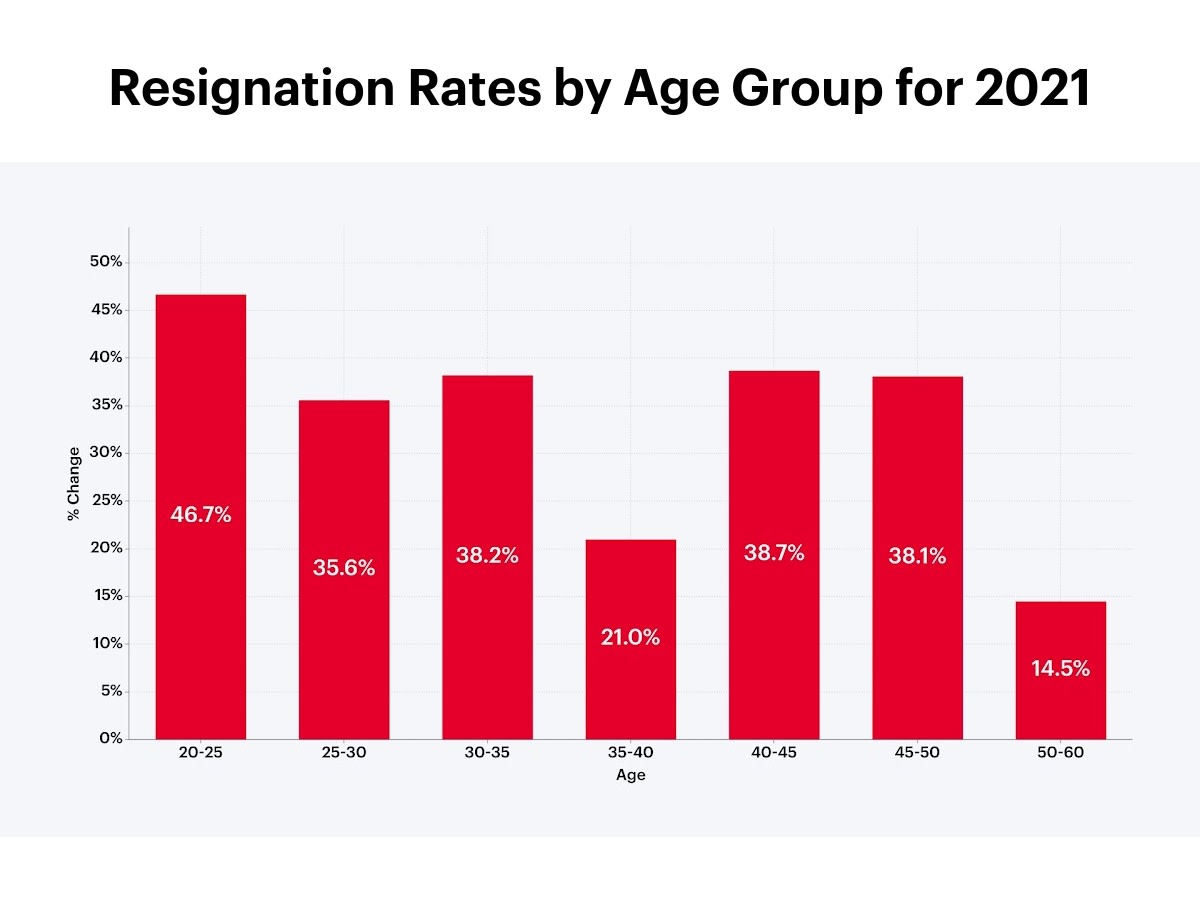The Great Resignation's Next Act: Manager Turnover
It's not just the volume of people quitting during the Great Resignation, it's who's leaving—managers. And they're taking people with them.

Details matter, particularly when considering why employees leave and how organizations are impacted by high employee turnover. 47.4 million Americans voluntarily left their jobs in 2021–a remarkable feature of the Great Resignation. But it’s who is quitting–not just volume–that is significant here.
Conventional wisdom holds that people tend to job hop when they are younger. Indeed, Baby Boomers and Gen Xers quit more often before they hit the age of 35. Older, experienced employees are typically considered to be more stable and slower to change.

But the current resignation wave is different. Our data team found new turnover patterns when it investigated the resignation rate increase between 2020 and 2021, using data from Visier Community People Data, a database of 10.7 million anonymized, standardized workplace records.
As expected, turnover rates for younger groups were up in 2021 as compared to 2020, but surprisingly, the resignation rate also rose significantly for older age groups. For employees in the 40 to 45 and 45 to 50 age categories, resignations increased by over 38%. For employees aged 25 to 30, the percentage change was smaller at 35.6%.

Resignation rate percentage increase 2020 to 2021 by age group. Resignation rates increased by more than 38% for employees in the 40-45 and 45-50 age categories. Source: Visier Insights™ Report: Stop The Exit.
Manager turnover: a key slice of the Great Resignation
Clearly, more experienced employees are rethinking their careers and taking their talents elsewhere. These figures also suggest that people who are at a critical point in the organizational hierarchy are now leaving in higher numbers: Between the ages of 40 to 50 is also when people are most likely to be managers. A recent analysis of talent movement data in our database across the past three years also shows that managers’ resignation rate went up in the second half of 2021.
Those managers who haven’t handed in their two weeks’ notice already are likely mulling it over. A Qualtrics survey of nearly 14,000 participants released in November 2021 revealed that intent to stay has dropped by 11 points for managers, compared to 7 points for individual contributors.
Of course, manager turnover is not the single biggest factor fueling high employee turnover rates. Other pressing challenges have emerged, such as a lack of people in frontline positions. But an uptick in manager resignations should also be a major concern for business leaders.
There are all the immediate impacts to consider, such as the high cost of replacing a manager and loss of institutional knowledge. But perhaps the biggest impact, which is not so easy to quantify, is the way manager turnover shapes the employee experience.

Need help with talent acquisition? Download our new guide for ten hiring strategies.
When a manager leaves, it impacts the entire team
According to Gallup, “managers account for 70% of variance in employee engagement.” What managers say and do affects other employees in terms of well-being and performance.
When a good manager leaves and a new, less competent replacement comes in, entire teams are affected. This HBR post by Tomas Chamorro-Premuzic, a business psychology professor, features a list of manager bad habits, including unpredictability and using negative words that can generate excessive anxiety in direct reports. In the long run, this is likely to lead to a depletion of resiliency among employees, a key concern during times of uncertainty.
There is also the potential for a dynamic called “turnover contagion.” Turnover contagion happens when people quit their jobs simply because coworkers are quitting. They think “what am I missing out on?” and decide to leave too.

Research suggests that employees can be more prone to quitting if they have a tight bond with a leader who is leaving the organization, according to a literature review conducted by researchers from the University of Memphis and the University of Houston. The literature review also refers to a phenomenon known as career shock: The departure of a leader can prompt employees to think about switching occupations entirely.
With turnover contagion in play, a few key managers calling it quits can trigger a cascade of resignations. Obviously, this kind of high employee turnover situation is something every employer wants to avoid.
3 reasons why managers quit–and what you can do about it
Employee retention became even more critical as the wave of resignations swept across the US. But while the Great Quit is pervasive, impacting all types of employers, HR leaders can’t just rely on industry-wide turnover numbers to craft workforce strategies. Nuanced data about the population with the biggest exit risk within their organizations, and the key drivers causing their unexpected exits, can help HR tackle turnover effectively.
That being said, there are common reasons why employees leave, and why managers in particular quit:
#1. Pay. According to an engagement and retention report released by Achievers Workforce Institute in February of 2021, 36% of employees were considering changing jobs for better compensation and corporate benefits. It’s possible that the shift to remote work has created an even greater demand for more experienced employees, giving managers greater leverage in securing new positions and higher pay. Gain a clear picture of which high-performing managers your organization absolutely needs to keep and consider offering these people salary increases. Nothing says “we value you” like higher pay.
#2. Family obligations. According to Qualtrics, intent to stay has dropped the most among female leadership. Our own data shows that women have been exiting at higher rates than men. This likely stems from the fact that women have been disproportionately shouldering childcare responsibilities during pandemic-induced school closures. Even as schools reopen, balancing family and work responsibilities is likely to remain a priority for experienced employees. Reach out to managers and seek their input into how the organization can best support them on this front.
#3. Work stress. In this new world of work, leaders are expected to take on additional responsibilities, including delivering on DEI promises, promoting employee well-being during periods of extreme uncertainty, and rallying geographically dispersed teams around deadlines. It’s not surprising, then, that a Gallup poll revealed that managers reported being burned out more often than individual contributors in 2020, and that this gap widened considerably in 2021–particularly for people managers. Look for ways to help managers reduce the stress associated with leading people. Consider providing managers with access to data that informs better decisions related to pay, promotions, employee well-being, and hiring.
Manager retention benefits everyone
It’s time to rethink the assumption that job hopping is a characteristic of carefree youth. Older, more experienced employees have also been swept up in the Great Resignation. Hone in on managers’ experiences and find ways to retain these critical people. More than just a few key employees will benefit from this approach–with satisfied, high-performing managers, entire teams can continue collaborating in meaningful ways, thus driving up employee satisfaction overall.


